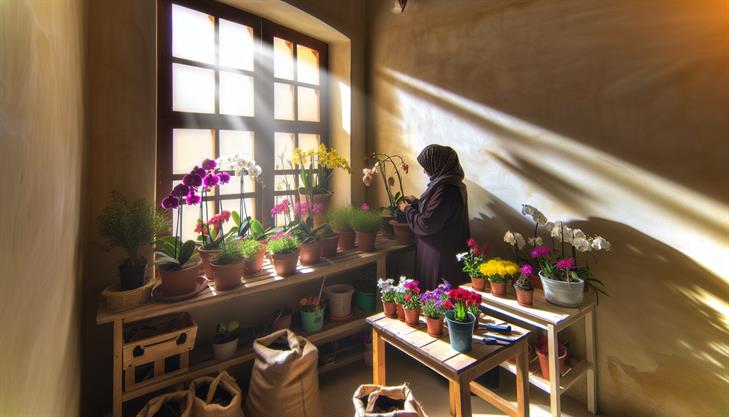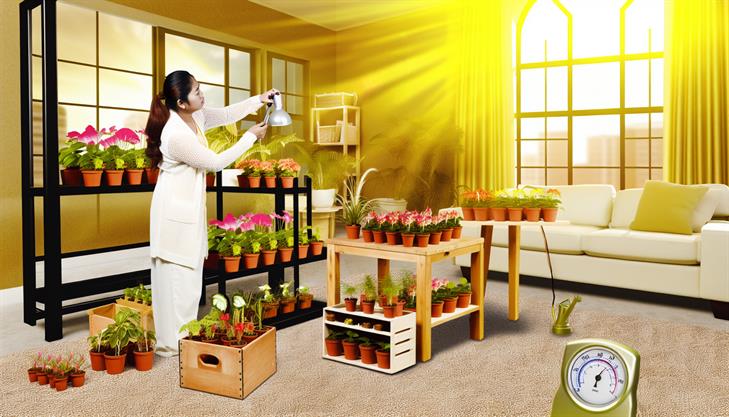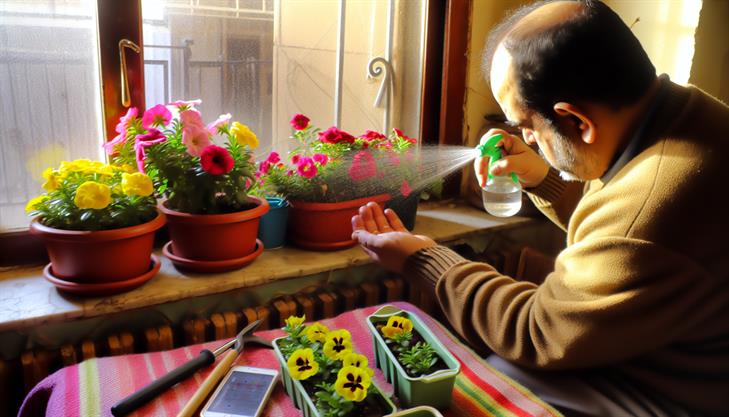In today’s fast-paced world, where outdoor space is often a luxury and city living confines us to high-rise apartments, the dream of cultivating nature’s vibrant colors might seem out of reach. Yet, the art of growing flowers indoors is not only possible but can bring unparalleled joy and tranquility into your everyday life. Imagine waking up to the delicate fragrance of blooming jasmine or the vivid hues of pansies and tulips right in your living room. Indoor flowers have the unique ability to brighten even the dullest corner, purify the air, and create a serene sanctuary of calm amidst the urban chaos. In this comprehensive guide, you’ll discover the secrets to thriving indoor gardens, from choosing the perfect flowers and understanding their sunlight needs to mastering the art of watering and nurturing your blossoming oasis. So whether you’re a seasoned gardener seeking to bring your passion indoors or a curious beginner ready to embark on a green adventure, read on to transform your home into a blooming paradise.
Getting Started: Choosing the Right Indoor Flowers
Growing flowers indoors is a rewarding endeavor that combines the beauty of nature with the comfort of home. With a bit of planning and care, you can cultivate vibrant flowering plants that enhance your living space. Here’s a guide to help you successfully begin your indoor flower gardening journey:
1. Choose the Right Flowers:
Selecting the appropriate flowers is crucial for successful indoor growth. Some popular choices include African violets, orchids, peace lilies, and begonias. Research each plant’s specific needs regarding light, water, and temperature to ensure they suit your home’s environment.
2. Establish Optimal Lighting:
Light is a critical factor for photosynthesis, and most flowering plants require sufficient exposure. Place your flowers near a south-facing window or use grow lights to supplement natural light. Ensure that the plants receive 12-16 hours of light daily, adjusting for seasons as needed.
3. Select the Appropriate Containers:
Choose pots that provide adequate drainage to prevent root rot. Material-wise, ceramic or plastic pots are often preferred for their durability and moisture retention properties. Ensure that the container size is appropriate for the plant’s growth potential.
4. Use Quality Potting Mix:
A high-quality potting mix is essential for indoor flowers as it supports good drainage and aeration. Consider using blends formulated specifically for indoor plants that include peat moss or coco coir for optimum results.
5. Watering Wisely:
Overwatering is a common issue when growing flowers indoors. It’s vital to understand each plant’s specific watering needs. A general rule is to water when the top inch of soil feels dry. Always allow excess water to drain away to prevent soggy soil conditions.
6. Temperature and Humidity Control:
Keep your plants in environments with temperatures between 65-75°F (18-24°C). Humidity is also important, especially for tropical plants like orchids. Maintain humidity levels around 50-60% by using a humidifier or placing a tray of water near the plants to increase moisture in the air.
7. Fertilization:
Indoor flowers generally need regular feeding during their growing seasons. Use a balanced, water-soluble fertilizer every 4-6 weeks. Be mindful not to over-fertilize, which can lead to salt buildup and damage plant roots.
8. Regular Maintenance:
Pruning dead or yellowed leaves encourages healthy growth and aesthetics. Also, inspect plants regularly for pests like aphids or spider mites. If detected, treat them with insecticidal soap or neem oil solutions.
9. Troubleshooting Common Problems:
Be vigilant in identifying the symptoms of common issues. Yellow leaves may indicate overwatering, while brown tips can suggest low humidity or nutrient deficiencies. Adjust care habits accordingly and seek advice from gardening communities if challenges persist.
By following these steps on how to grow flowers indoors, you can create a thriving indoor garden that adds life and color to your home. Remember that each plant might have unique requirements, so tailoring your approach ensures the best results. As you become more familiar with your plants’ needs, the joy of indoor flower gardening will continue to blossom.
Optimizing Your Indoor Environment for Flower Growth
Growing flowers indoors can transform your living space into a vibrant, aromatic haven while providing a rewarding gardening experience regardless of the season. Here are step-by-step guidelines and advice to help you create the ideal indoor environment for your flowers to thrive:
Choose the Right Flowers
Begin by selecting flower varieties suited for indoor cultivation. Easy-to-grow flowers indoors include African violets, orchids, peace lilies, and geraniums. Consider factors like light level preferences and care requirements of each plant when making your choice.
Prepare the Planting Containers
Opt for pots with adequate drainage holes to prevent water from accumulating, which can lead to root rot. Consider using trays underneath to catch excess water. Using a good-quality potting mix tailored for flowers ensures proper drainage and nutrient supply, essential for how to grow flowers indoors successfully.
Ensure Optimal Lighting
Light is a critical factor in the growth of indoor flowers. Most flowering plants require bright, indirect light to flourish. If natural light is insufficient, consider investing in LED grow lights, which are energy-efficient and provide the full spectrum of light that flowers need. Position your plants within 6-12 inches of the light source for optimal growth.
Regulate Temperature and Humidity
Most indoor flowers prefer temperatures between 60-75°F (15-24°C). Extreme fluctuations can stress plants, so maintaining a stable environment is crucial. Humidity is another important aspect, especially in heated homes during winter months. Using a humidity tray or a room humidifier can help maintain humidity levels conducive to how to grow flowers indoors effectively.
Implement Proper Watering Techniques
Over- or under-watering is a common issue that can impede the growth of indoor flowers. Touch the soil surface—if it feels dry, it’s time to water. Water your plants until it begins to drain from the bottom of the pot, ensuring roots receive adequate moisture. Avoid letting plants sit in standing water.
Fertilize Regularly
Indoor plants require regular feeding to bloom beautifully. Use a balanced, water-soluble fertilizer designed for flowering plants. Follow manufacturer instructions for dilution and frequency, usually around every 4-6 weeks. Regular fertilizing supports vibrant blooms and robust plant health.
Monitor for Pests and Diseases
Inspect your plants regularly for signs of pests like aphids, spider mites, or fungal diseases. Promptly isolate affected plants and treat them with natural remedies or insecticidal soap. Keeping foliage clean by gently wiping leaves with a damp cloth can help prevent pest infestations.
Additional Tips
- Rotate Plants Regularly: To ensure even growth, rotate your pots once a week, so all sides receive equal light exposure.
- Prune Spent Blooms: Regularly deadhead spent flowers to encourage new growth and prevent disease.
- Repot When Necessary: As plants grow, they may require repotting into larger containers to provide room for their expanding root systems.
By following these guidelines on how to grow flowers indoors, you can cultivate a lush and thriving indoor garden. Remember, each plant species may have unique needs, so take time to research specific care tips for the flowers you choose to grow. Happy indoor gardening!
Essential Tools and Accessories for Indoor Gardening
Growing flowers indoors can transform any space into a vibrant oasis, offering beauty and even improving air quality. If you’re wondering how to grow flowers indoors successfully, here’s an easy-to-follow guide that will help you thrive in your floral endeavors.
Step 1: Choose the Right Flowers
Begin by selecting flowers that are well-suited for indoor growth. Some popular choices are African violets, peace lilies, orchids, and begonias. These varieties not only adapt well to indoor environments but also add stunning visual appeal.
Step 2: Understand the Light Requirements
One of the most vital aspects of growing flowers indoors is providing adequate light. Most flowering plants need bright, indirect sunlight. Evaluate the light available in your home and consider using LED grow lights to supplement natural light, especially in rooms with limited sunlight.
Step 3: Select the Appropriate Containers
Choose pots with good drainage holes to prevent waterlogging. This step is crucial as excess water can lead to root rot, a common issue in indoor gardening. Lightweight, breathable materials like terracotta or ceramic are excellent for ensuring proper air circulation.
Step 4: Use the Right Soil Mix
Opt for a high-quality potting mix that is suited for flowering plants. These specialized mixes provide ample nutrients and retain the right amount of moisture without becoming too compacted. Avoid using outdoor soil, as it often lacks the necessary drainage and can introduce pests indoors.
Step 5: Maintain Optimal Humidity and Temperature
Most indoor flowers thrive in environments with humidity levels between 40% to 60%. Consider using a humidifier, especially during the dry winter months. Keep your flowers in a stable temperature range of 65-75°F, avoiding drafts and extreme temperature fluctuations.
Step 6: Water Wisely
Understanding the watering needs of your indoor flowers is essential. Over-watering is a common pitfall, so make sure you know each plant’s requirements. Typically, it’s best to water when the top inch of soil feels dry to the touch.
Step 7: Fertilize Regularly
Indoor flowers benefit from regular feeding, especially during their growing season. Use a balanced, water-soluble fertilizer every four to six weeks. Be cautious not to over-fertilize, as this can damage your plants. Follow the instructions on the fertilizer package carefully.
Step 8: Prune and Deadhead
To promote healthier growth and flowering, remove any dead or yellowing leaves and spent blooms promptly. Trimming plants encourages new growth and helps prevent diseases. Use clean, sharp scissors or pruning shears to avoid damaging the plant.
Common Issues and Troubleshooting
If your indoor flowers develop yellow leaves or stunted growth, assess water and light conditions. Spider mites and aphids are common pests; treat them with insecticidal soap or neem oil if needed. Consistently check for signs of stress or disease, addressing issues immediately to keep your plants healthy.
Additional Tips
For a successful indoor flower garden, regular attention is key. Rotate your plants occasionally for even light exposure and repot them every couple of years to refresh the soil. Integrating flowering herbs like lavender or chamomile can not only enhance your indoor display but also offer delightful fragrances.
By following these steps on how to grow flowers indoors and maintaining attentiveness to your plants’ needs, you can enjoy a thriving indoor garden that continuously blooms with beauty and life.
Nurturing and Caring for Your Indoor Blooms
Growing flowers indoors can bring a splash of color and life to any home environment, providing a year-round gardening experience regardless of the outdoor climate. For those exploring how to grow flowers indoors, these guidelines will walk you through the essential steps, ensuring your indoor garden thrives.
Choosing the Right Flowers
Start by selecting the appropriate flower types for indoor growth. Some popular choices include African violets, orchids, peace lilies, and begonia. Consider the lighting conditions of your home and the flower’s light, temperature, and humidity requirements.
Setting Up Your Indoor Flower Garden
-
Find the Perfect Spot: Choose a location that meets your selected flowers’ light and temperature needs. Bright, indirect sunlight suits most indoor flowers, while some might need direct sunlight for several hours each day.
-
Select Suitable Containers: Your pot should have drainage holes to prevent waterlogging, which can cause root rot. If aesthetics are a concern, use decorative containers with internal drainage solutions.
-
Use Quality Potting Mix: Choose a potting mix specific to indoor plants, which provides proper aeration and drainage. Avoid using garden soil, which is too dense for potted environments and may harbor pests.
Planting Your Flowers
-
Prepare the Container: Fill your pot or container with potting mix, leaving approximately an inch from the top. This space allows for watering without overflow.
-
Plant with Care: If your plant came in a starter container, gently loosen its roots and place it into the new pot, filling around it with more mix. Ensure the base of the plant is level with the top of the soil.
-
Water Wisely: Immediately after planting, water your flowers thoroughly, ensuring the soil is evenly moist but not soggy.
Maintaining Indoor Flowers
-
Regular Watering: Consistency is key. Check the soil moisture by inserting your finger about an inch in; water if it’s dry. Most indoor flowers thrive on a weekly watering routine, but adjust based on humidity levels.
-
Feeding Your Plants: Fertilize with a balanced houseplant fertilizer every 4-6 weeks during the growing season. Reduce feeding during the dormant winter months when growth slows.
-
Prune and Deadhead: Remove any dead or yellowing leaves, and deadhead spent blooms to encourage further flowering and maintain plant health.
Troubleshooting Common Issues
-
Yellowing Leaves: Usually a sign of overwatering or poor drainage. Ensure your pot has drainage holes and reduce watering frequency if needed.
-
Powdery Mildew: Keep humidity levels in check and ensure adequate air circulation around your plants. Fungicides can help treat severe cases.
-
Pest Infestations: Common pests like aphids and spider mites can be managed with regular inspection and natural insecticidal soaps or neem oil treatments.
Additional Tips for Success
- Rotate Your Plants: Turn your plants occasionally so all sides receive equal light.
- Humidity Boosters: If your home has low humidity, consider using a humidity tray or a small humidifier.
- Seasonal Adjustments: As natural light varies with seasons, you might have to relocate plants or supplement their light during shorter winter days with grow lights.
By following these detailed steps on how to grow flowers indoors, you can create a beautiful and healthy indoor garden that enhances your living space. Remember, successful indoor gardening involves patience, observation, and adjustment to your plant’s specific needs over time.
Troubleshooting Common Indoor Flower Growing Issues
Growing flowers indoors is a rewarding and engaging hobby that allows you to enjoy beautiful blooms year-round, even if you’re short on outdoor space. To successfully cultivate indoor flowers, follow these essential steps and address common issues that may arise.
Choosing the Right Flowers
Start by selecting the right flowers for indoor growing. Some popular choices include African violets, peace lilies, orchids, and indoor begonias. Consider the natural light in your home, as some plants require more light than others. Opt for low-light adaptable plants if your space is dim.
Setting Up Your Indoor Garden
-
Lighting: Lighting is crucial when growing flowers indoors. Place your plants close to windows that receive bright, indirect sunlight. If natural light is insufficient, invest in grow lights, which can mimic sunlight and are adjustable to provide the ideal light spectrum for blooming.
-
Temperature and Humidity: Most indoor flowers thrive in temperatures between 65°F and 75°F. Avoid placing plants near drafts or heat sources. Use a humidifier if your environment is particularly dry, as many indoor plants prefer humidity levels around 50%.
-
Containers and Soil: Use pots with adequate drainage holes to prevent waterlogging. A high-quality potting mix is essential for providing the right nutrients and support for root development. Consider a mix that includes peat moss or perlite for better aeration.
-
Watering: Overwatering is a common pitfall. Check the soil moisture by inserting your finger about an inch deep; water only when the topsoil feels dry. Use room-temperature water to avoid shocking the roots.
Maintenance Tips
-
Feeding: Fertilize every 4-6 weeks with a balanced, water-soluble fertilizer. Reduce feeding frequency during the dormant winter months.
-
Pruning: Regularly remove dead leaves and spent blooms to promote healthy growth. Pruning encourages the development of new flowers and prevents disease.
-
Pest Control: Keep an eye out for common pests like aphids or spider mites. Natural pest control alternatives include neem oil or insecticidal soap.
Troubleshooting Common Issues
-
Yellowing Leaves: This might indicate overwatering or poor drainage. Check your watering schedule and ensure that excess water can escape the pot.
-
Lack of Blooms: Insufficient light or nutrients can cause your flowers not to bloom. Assess the lighting conditions and consider a fertilizer boost.
-
Wilting or Drooping: Sudden wilting can be a sign of underwatering or excessive heat. Adjust watering practices and move plants away from heat sources.
To maximize your success when learning how to grow flowers indoors, experiment with different plant species and observe how they respond to your home’s environment. By understanding their needs and addressing challenges head-on, you can create a vibrant indoor garden that fills your space with color and life. Enjoy the process, and don’t hesitate to make adjustments as you gain more experience.
In conclusion, growing flowers indoors not only enhances your living space but also brings nature’s vibrant beauty into your home. By selecting the right flower varieties that thrive indoors and understanding their specific lighting, temperature, and watering needs, you can create a flourishing indoor garden. Remember to provide adequate humidity and choose well-draining potting soil to support healthy root systems. Regularly monitor your plants for signs of pests or nutrient deficiencies and adjust your care routine as needed.
By applying these strategies, you’ll be well on your way to cultivating a lush and colorful indoor flower garden that can be enjoyed year-round. As a final tip, consider rotating your flower pots regularly to ensure even light distribution and to encourage balanced growth. With patience and attention to detail, your efforts will be rewarded with blooms that brighten your home and uplift your spirits. Happy gardening!


